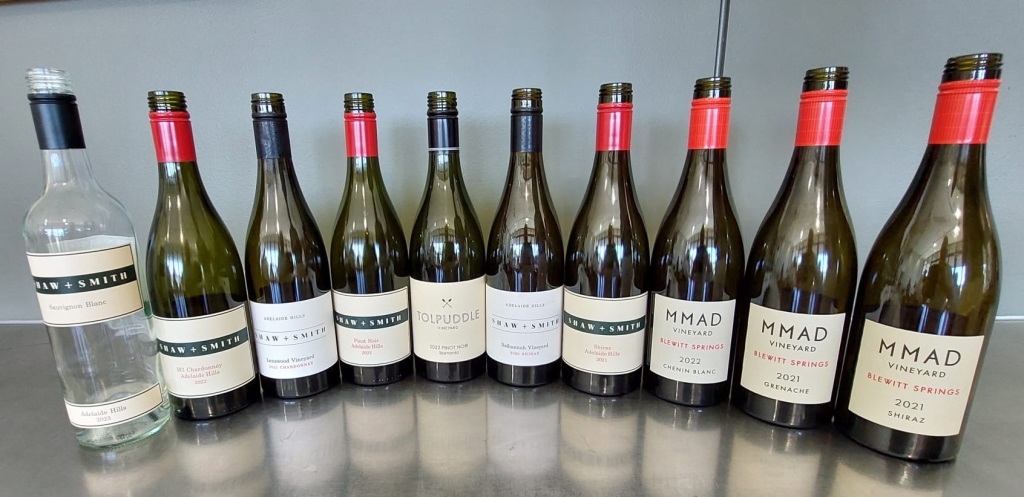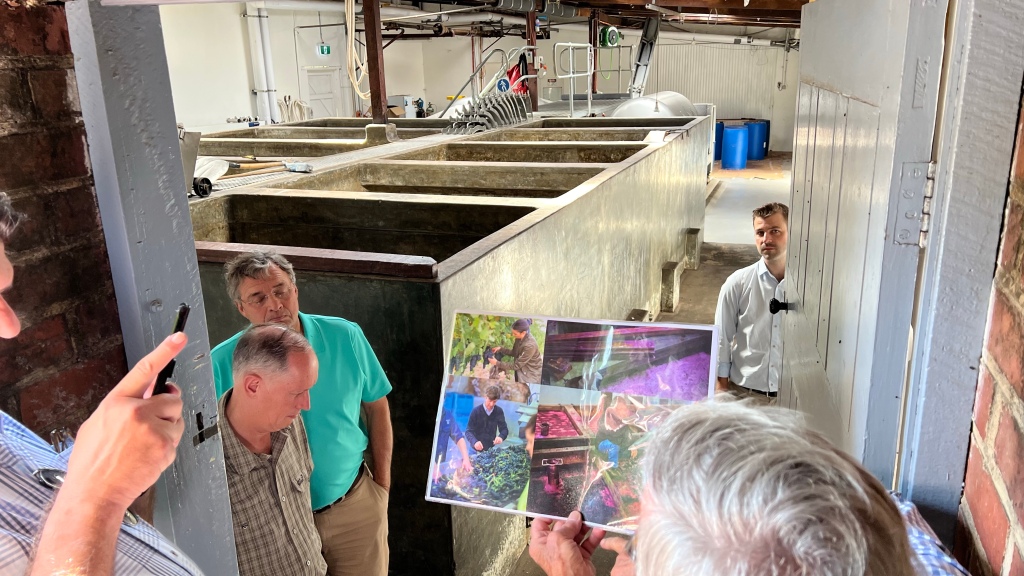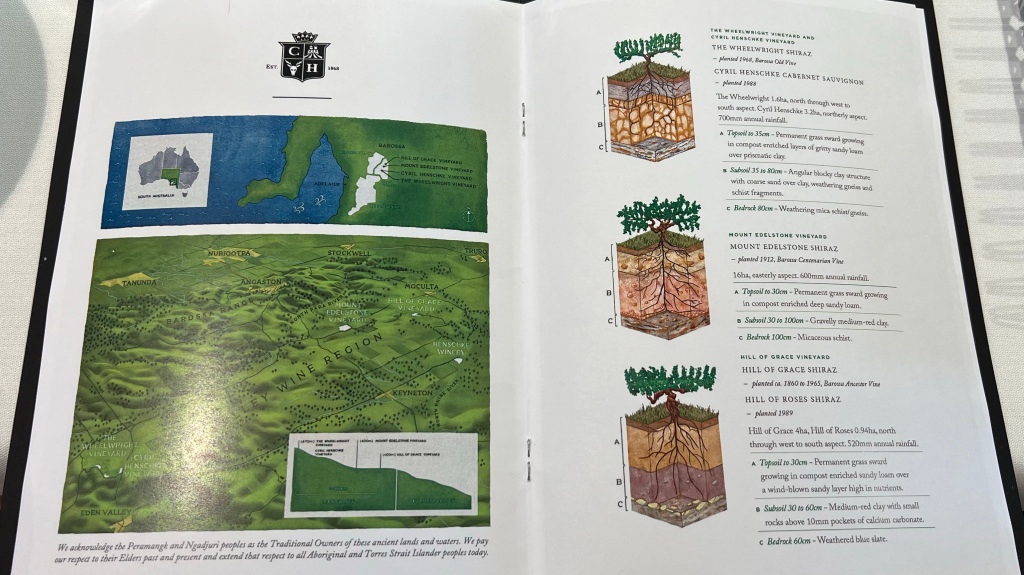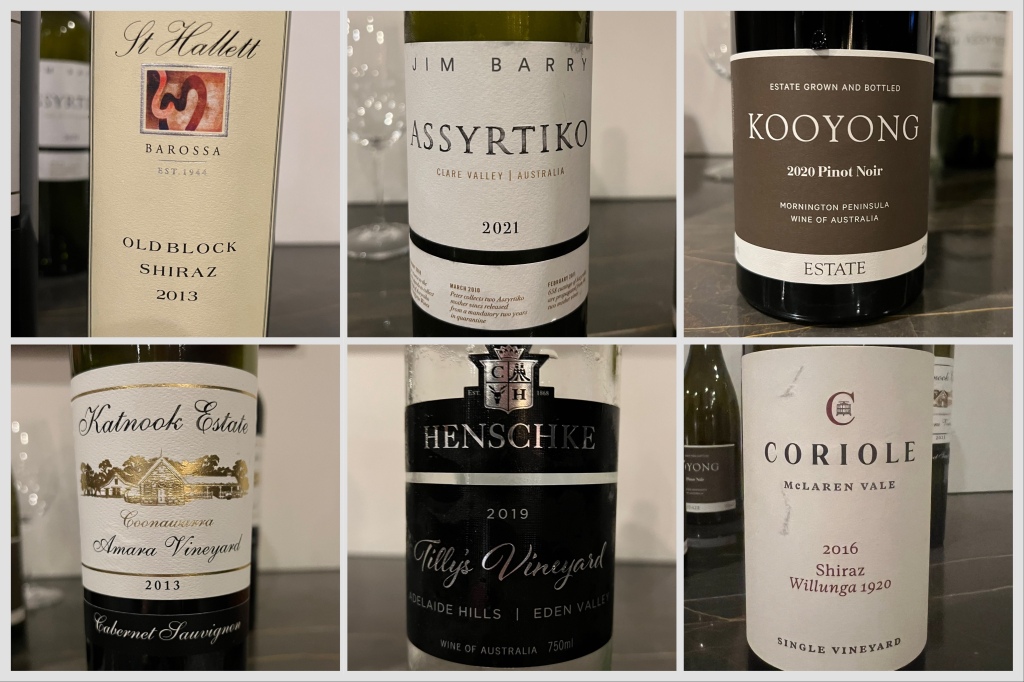
Today we visited Adelaide Hills, the coolest wine region in South Australia because of the high elevation (about 400 meters above sea level).

Shaw + Smith is a winery founded by Martin Shaw and Michael Hill Smith. Their first vintage was 1990. Originally this region was thought to be too cool for wine, but the cool climate is ideal for Chardonnay, Pinot Noir, and sparkling wines. S+S acquired Tolpuddle in Tasmania in 2011, so we also tased some wines from Tasmania. Martin Shaw and Michael Hill Smith teamed up with Adam Wadewitz and David LeMire to start MMAD (Martin Michael Adam David). They acquired vineyards with old vines of Chenin, Grenache and Shiraz in McLaren Vale.

We started today’s tasting with another blind International tasting, this time of Chardonnay. The Chardonnays were tasted blind and we had to guess where they were from. Only after tasting it was revealed what we had been tasting.

These were the Chardonnays we tasted:
- Weingut Friedrich Becker, Mineral Chardonnay 2017, Pfalz, Germany: racy acidity, oak
- Kershaw, Chardonnay 2019, Elgin, South Africa: restrained aroma, bitter finish
- Blank Canvas, Reed Vineyard Chardonnay 2021, Marlborough, New Zealand: mineral, fresh, balanced, complex
- Wijnkasteel Genoels Elderen Chardonnay Goud 2016, Belgium: developed, acidity balanced with complexity
- Kumeu River Hunting Hill Chardonnay, New Zealand: mineral, acidity
- Shaw & Smith M3 Chardonnay 2021, Adelaide Hills, Australia: delicate, balance
- Tolpuddle Chardonnay 2022, Tasmania, Australia: nervy, youthful
- Bonneau du Martray Corton-Charlemagne Grand Cru 2016, Burgundy, France: power, finesse, complex
- Errazuriz Chardonnay Las Pizzaras 2017, Aconcagua Costa, Chile: restrained aroma, racy acidity
- Le Domaine d’Henri, Chablis 1er Cru Fourchaume 2016, Burgundy, France: botrytis?
- Torres Milmanda 2017, Penedès, Spain: developed, almond
- Domaine Chanson, Chassagne-Montrachet Les Chevenottes 2015, Burgundy, France: oak, balanced, complex
- Moone-Tsai Chardonnay 2019, Sonoma Coast, California, United States: pineapple, developed
- Shaw + Smith Lenswood Chardonnay 2019, Adelaide Hills, Australia: complex, balanced
- Young Hagen, Platt Vineyard Chardonnay 2017, Sonoma Coast, California, United States: developed, opulent

My favorites were the Corton-Charlemagne, Chassagne-Montrachet, and S+S Lenswood. It was interesting to see that the group was rarely unanymous on whether the Chardonnay was from the old world or the new world. This demonstrates again how difficult it is to tast blindly.

We continued with a tasting of wines from Shaw + Smith and MMAD. S+S prefers to specialize on the varities they have rather than adding new varieties.

It was clear from the tasting that the wines have a clean style, staying away from heavy use of oak, and bringing out the fruit.

These were the wines we tasted:
- Shaw + Smith Sauvingnon Blanc 2023: crisp and bright
- Shaw + Smith M3 Chardonnay 2022: subtle oak, balance
- Shaw + Smith Lenswood Vineyard Chardonnay 2021: restrained aroma, elegant, subtle oak
- Shaw + Smith Pinot Noir 2023: perfumed,, delicate
- Tolpuddle Vineyard Pinot Noir 2022: complex in aroma and texture, juicy, balanced
- Shaw + Smith Shiraz 2021: perfumed, jammy fruit, ripe tannins
- Shaw + Smith Balhannah Vineyard Shiraz: power, structure, balance, needs time in the bottle
- MMAD Vineyard Chenin Blanc 2022: structured and elegant
- MMAD Vineyard Grenache 2021: perfumed red fruit, elegant
- MMAD Vineyard Shiraz 2021: perfumed dark fruit, charming and elegant

We finished our visit to Shaw + Smith with lunch:
- Smoked ocean trout
- Burrata with pickled zucchini and chives
- Eggplant Hummus
- Duck rillette
- Wagyu Bresaola with figs
- Cnarcuterie with pickles

Our schedule is quite full, so I write these blogs on the bus while we are on the way from one winery to the next.

Our next stop was Henschke, a family-owned winery with a long history in the Eden Valley. It was established in 1868 and we were received by the 5th and 6h generation winemakers, Stephen and his son Andreas. Mount Eldestone, created in 19522 by 4th Generation Cyril Henschke, is the longest consecutively produced single vineyard varietal wine in Australia. Stephen’s wife Prue has introduced biodynamic farming practices in all of their vineyards. One of the advantages of a green soil rather than a barren soil is that it provides natural cooling. Eden Valley has a larger difference between day and night temperatures (called diurnal range) than Barossa, which is important for the aromatic development of the grapes. Stephen is a strong advocate of screwcaps over corks; according to him it preserves wine much better by shielding it from oxidation.

We started with a tour of the historical cellar.

The main varieties of Henschke are Riesling and Shiraz, and that is what the tasting focused on:
- Peggy’s Hill 2023 (100% Riesling): yellow apple, citrus, crisp.
- Julius 2023 (100% Riesling): restrained aroma because it is still young, complex, concentration
- Henry’s Seven 2022 (72% Shiraz, 15% Grenache, 11% Mataro (Mourvèdre), 2% Viognier, 8 months in seasoned French oak): black pepper, fresh, medium body
- Johann’s Garden 2022 (79% Grenache, 21% Mataro (Mourvèdre), from Barossa, 10 months in seasoned French oak): restrained aroma, round, soft with an edge from the high alcohol
- Keyneton Euphonium 2019 (52% Shiraz, 25% Cabernet Sauvignon, 12% Cabernet Franc, 11% Merlot, 18 months in oak (80% French, 20% American; 17% new): the Cabernet Sauvignon character dominates with strong but ripe tannins and blackberry/blackcurrant aromas
- The Wheelwright 2018 (100% Shiraz from old vines planted in 1968, aged 18 months in oak (65% French, 35% American; 21% new): black pepper, berries, soft velvety tannins, beautiful fruit.
- Mount Edelstone 2018 (100% Shiraz from old vines planted in 1912, aged 20 months in oak (77% French, 23% American; 27% new): jammy blackberry fruit, velvety tannins.
- Hill of Grace 2018 (100% Shiraz from old vines planted around 1860, aged 18 months in oak (83% French, 17% American; 20% new): complex and elegant, needs more time in the bottle.

It was an amazing opportunity to be able to taste the three Shiraz wines from vines from ~50, ~100 and ~150 years old in a horizontal tasting (different wines of the same vintage). Right now the Mount Edelstone was nicer to drink than the Hill of Grace, although I expect that with time the Hill of Grace will be more complex. There is no phylloxera in South Australia and the old vines are still on their own roots; they are among the oldest surviving vines on the planet.

We had dinner at the Coal Cellar + Grill, conveniently located in the Hilton in Adelaide where we were staying. I had a kangaroo tataki (delicious!) followed by rack of lamb (I am not sure how they managed to cook it well done on the outside and raw on the inside).

Of course there was wine as well:
- Henschke Tilly’s Vineyard 2019 (blend of Semillon, Pinot Gris, Riesling, Chardonnay, Sauvignon Blanc)
- Kooyong Pinot Noir 2020 Mornington Peninsula
- Katnook Estate Amara Vineyard Cabernet Sauvignon 2013 Coonawara
- St Hallett Old Block Shiraz 2013 Barossa Valley
- Coriole Willunga 1920 Shiraz 2016 McLaren Vale
- Jim Barry Assyrtiko 2021 Clare Valley


Daresay this is but the beginning of your South Australian journey – quite a few areas of interest there – Henacke’s wines must have been amongst the first we drank coming from Europe a lifetime ago. Trying to be diplomatic ,being first and foremost interested in food myself I do hope you will have an opportunity to visit one or two restaurants away from the hotel belt ! Some superb eateries in town !!! I wondered when on earth you composed your posts . . . and thanks for the photo . . . hmm, we of course are nowhere near shorts yet 🙂 !!
LikeLiked by 1 person
Upon a second reading – am rather thrilled perusing the results of the ‘Chardonnay blind tasting’.! If expert vinologists had a ‘problem’ tasting worldwide samples . . . does this not suggest an open mind when we choose and buy !!!
LikeLiked by 1 person
Well this trip has already shown that clichés about Australian wine are not always true. But isn’t that always the case with clichés? And also, “old world” or “new world” is not a quality distinction but rather a difference in style. On average, new world wines are more easily approachable than old world wines. But there are large variations around that average.
LikeLiked by 1 person
Well, being a wine lover with somewhat more knowledge than the man on the street but hugely less than people like you . . . and also taking one’s pocketbook into consideration . . . I choose by previous experience, reading and recommendation, vineyard/area, hoped/for match with planned food and . . . well: price 🙂 ! As we have been unable to ship our wines to China awhile, many local specials have been on the scene! As I am rather fond of many of the local ‘brews’ just as well I am unaware of the cliches . . . but can imagine!!! OMG – have even tried what is in some of those
casks’ of boxed wine !!!!
LikeLiked by 1 person
PS so what I am saying is that if you choose and buy a wine without tasting it first, just by the label and price, you should still pick one from the new world if you want a more approachable wine and vice versa to have the best chance of getting what you are looking for. But it is certainly no guarantee.
LikeLiked by 1 person
My dad’s parents came to Canada from Australia. This is one more reason for me to visit some of my ancestral lands.
LikeLiked by 1 person